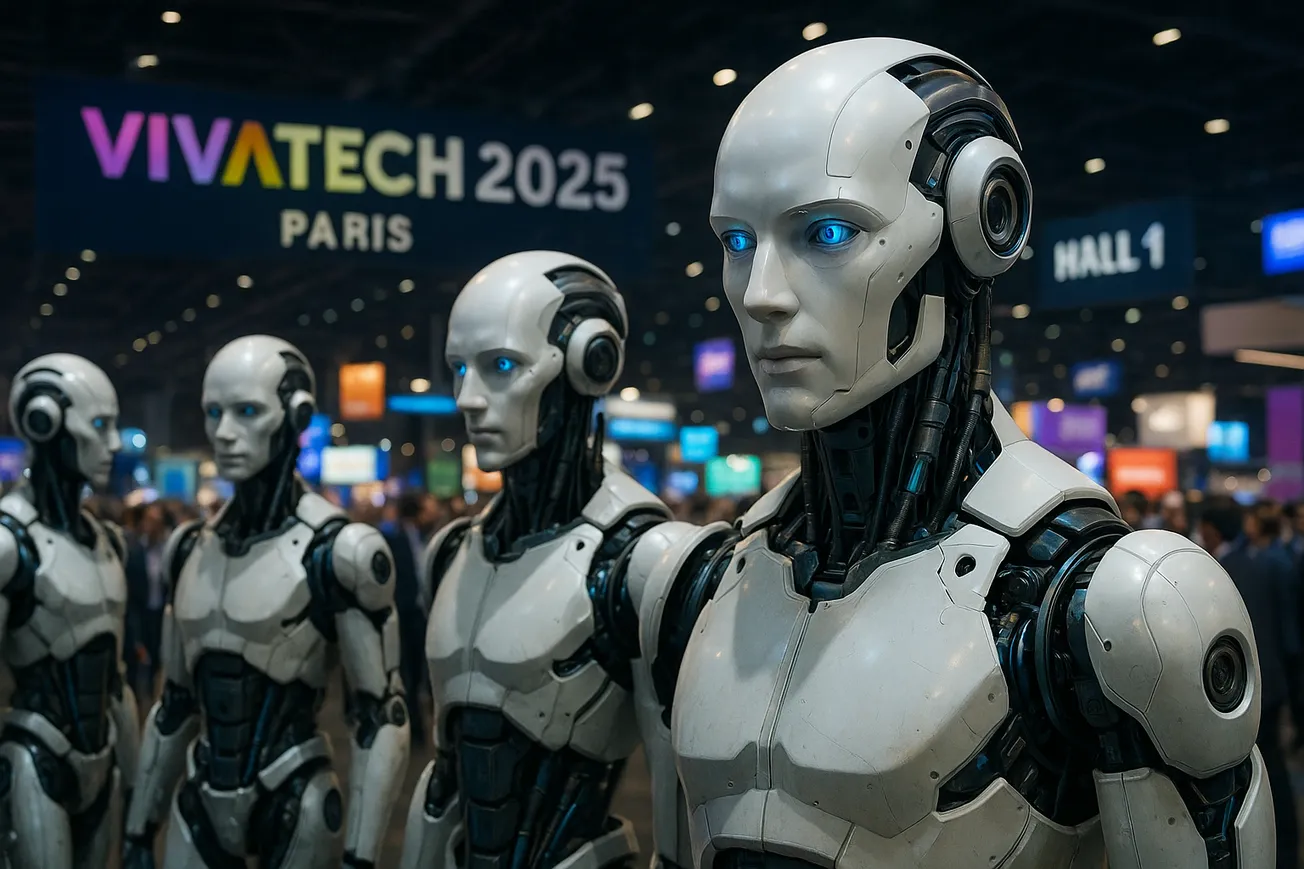Artificial intelligence, particularly AI agents and agentic systems, dominated VivaTech 2025, with over 40% of exhibitors showcasing AI-related innovations.
Of course, AI is nothing new at VivaTech. But this year, a significant shift from single-agent applications to multi-agent systems was evident throughout the conference. Industry leaders predicted that 2025 would be "the year of agents," with autonomous AI systems capable of collaborating with each other to solve complex problems.
These multi-agent systems are designed to handle high-impact challenges that typically require the involvement of multiple business disciplines, enabling enterprises to solve complex problems with trust and scale. Exhibitors, executives, and engineers explore how agentic systems are pushing the boundaries of automation, redefining software development, and (hopefully) translating years of AI hype into measurable impact.
Coding Gets a Copilot
GitHub CEO Thomas Dohmke discussed how AI is rewriting the future of software development. GitHub Copilot, already used by over 15 million developers, is no longer just autocompleting lines of code. It’s morphing into an autonomous coding agent capable of writing, testing, and debugging entire programs.
“Copilot started as autocomplete,” Dohmke explained. “Now, agents can create files, run tests, interpret outputs, and fix bugs independently.” But with that power comes risk. Dohmke emphasized the need for human oversight, especially in high-stakes environments. “We’re still far from the day when you trust an agent to book your vacation without checking the results,” said.
And while some worry about job displacement, Dohmke sees an expansion in scope: “More code will be written, not less. AI won’t replace developers It will demand more of them.”
Agents are already reshaping the entire software delivery lifecycle.
At Siemens, Devina Pasta described using GenAI not just for code, but for testing, QA, debugging, and support. Siemens’ “Industrial Copilot,” built with NVIDIA, enables workers to instruct machines via natural language and even debug without writing a line of code.
As Eiso Kant of Poolside noted, enterprises are starting to treat agents as elastic digital labor: “If I need to accelerate a six-month project to two, I don’t need to hire. I just spin up 1,000 agents.”
But this requires new infrastructure. Poolside is building systems to manage thousands of agents, with version control, access governance, and explainability. “You’re not just reviewing code anymore. You’re reviewing decisions made by your AI employees,” Kant said.
AgentForce: Salesforce’s Digital Workforce
Salesforce showcased its “AgentForce” platform: a full-stack system that enables companies to create and deploy AI agents as digital employees. Whether it’s customer service, sales prospecting, or internal policy support, these agents can be deployed across channels like Slack, Teams, and WhatsApp in a matter of minutes.
Paul Medevielle, VP at Salesforce, underscored the platform’s maturity: “We’re no longer in the POC phase. This is about time to value. Clients are going live at scale.”
At the Royal Bank of Canada, agents prepare client meetings in under two minutes, down from two hours. At Adecco, agents handle candidate interactions outside business hours, covering over 70% of inbound queries.
Agents, Productivity, and the GenAI Paradox
But if AI agents are so powerful, why haven’t we seen a consistent bottom-line impact?
That question was explored by several panels, including “Smart Gains: How Are AI Agents Unlocking Productivity?” and “Addressing the GenAI Paradox,” where QuantumBlack’s Stéphane Bout and Alexander Sukharevsky unpacked the disconnect.
Their diagnosis: most companies are deploying AI superficially, layering agents atop old workflows instead of rethinking them from the ground up. True productivity, they argued, comes when businesses use agents to redesign processes, which leverages their real-time adaptability, task parallelization, and ability to operate 24/7.
In one case, a digital factory built with 100+ agents reduced the cost of modernizing a legacy system by 50%, cutting the timeline by 30%.
McKinsey senior partner Nicolas Maechler noted that while the promise of AI agents is massive, integrating them into legacy systems, customer-facing environments, and employee workflows remains a complex challenge. According to Maechler, companies must manage not just data infrastructure but also human change management and financial planning.
One standout case from a recent McKinsey study: a bank using agents to modernize a $600M legacy platform saw a 50% productivity boost and 30–40% cost reduction—a signal that with the right setup, ROI is not just possible but substantial.
For Vincent Colegrave, Head of AI Strategy at Syensqo.ai, the key to unlocking agent-driven productivity lies not in flashy demos, but in grounded execution. Speaking on the “Smart Gains” panel, Colegrave shared how the company is scaling its “Sales Buddy” agent, a GenAI-powered assistant that helps commercial teams spot untapped revenue opportunities.
Its success, he emphasized, comes from constant co-creation with end users and rapid iteration cycles: “This is a technology made by people, for people, with impact at the core.”
Specialized Agents, Better Results
The future belongs to specialized agents. As IBM’s Kate Soule put it, “We’re shifting from AI that knows everything to AI that does specific things well.” Panels like “Less Is More: How Specialized AI Drives Business Value” highlighted how domain-specific models outperform general-purpose ones in accuracy, cost, and latency.
At DeepL, AI agents translate technical documents and legal contracts with near-native fluency. At AWS, agentic stacks combine multiple small models to deliver high-performance, low-latency outputs.
As Suzanne Seitinger of AWS noted, “It’s not just one agent doing everything. It’s a system of agents, each optimized for a different part of the task.”
Laying the Groundwork for Scalable Agents
Christian Buckner, SVP at Altair, brought a pragmatic lens to the “Smart Gains” discussion. His message: the promise of AI agents is real, but scaling them demands more than vision. It requires solid foundations.
“Agents don’t just analyze, they act,” Buckner said. But for that to work, they need data that’s connected, contextual, and controlled. Too often, legacy issues like siloed data and unclear ownership derail agent deployments before they start.
Buckner emphasized that GenAI raises the stakes: agents require broader context and stricter guardrails than any previous generation of tools. Without the right foundations, both in data infrastructure and governance, projects fail.
From Assistants to Operators
Among the headline announcements was OpenAI’s forthcoming launch of “Operator,” a next-gen agent capable of browsing the web and handling multi-step workflows. Although early results remain limited, the potential is vast.
McKinsey introduced its “Agents at Scale” platform: a modular suite designed to help enterprises deploy and govern agent ecosystems. With orchestration tools, integration frameworks, and repositories, the system aims to address the steep barriers to scaling this technology across entire organizations.
Scaling Trust and Governance
For all their promise, agents raise tough questions: How do you supervise them? Who is accountable? How do you prevent hallucinations?
AXA’s Christophe Vermont offered a model approach. The insurance giant rolled out conversational agents to assist internal teams, but embedded the program within a broader HR and union strategy. “We gave full transparency to employee representatives, brought them into testing, and built trust step by step,” Vermont said.
The company’s “Secure GPT” and “Smart in AXA” agents now handle claims, coach drivers, and assist sales reps to free up employees for more complex, value-added work.






